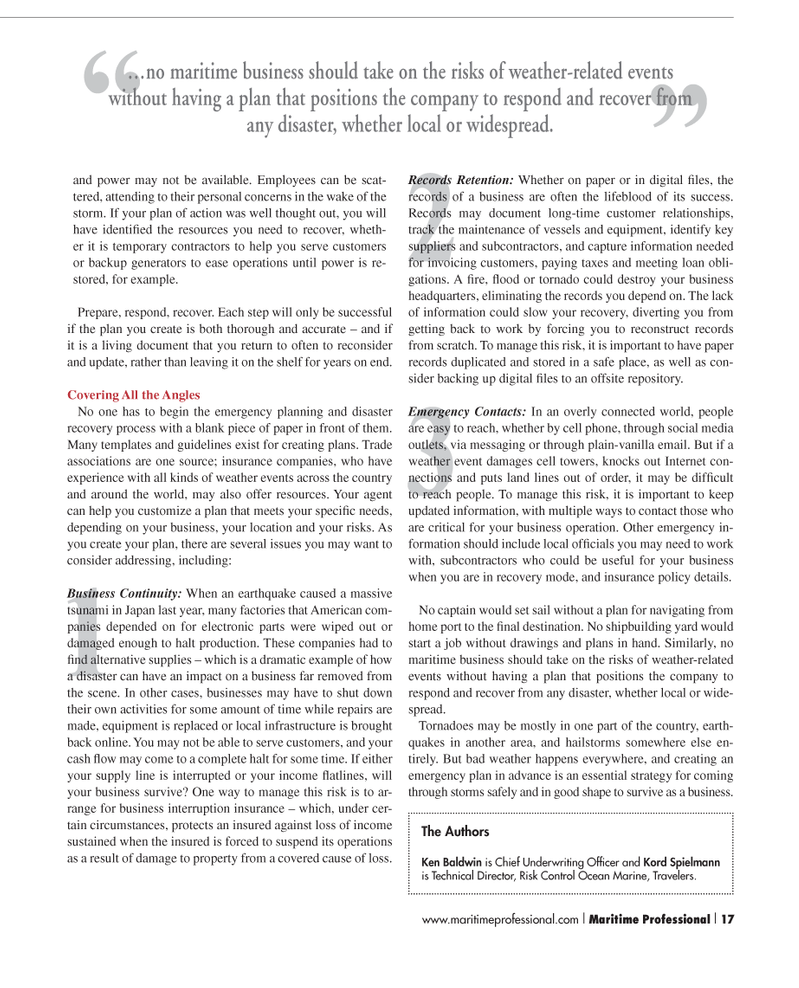
Page 17: of Maritime Logistics Professional Magazine (Q2 2012)
Maritime Risk
Read this page in Pdf, Flash or Html5 edition of Q2 2012 Maritime Logistics Professional Magazine
1 2 3 and power may not be available. Employees can be scat- tered, attending to their personal concerns in the wake of the storm. If your plan of action was well thought out, you will have identifi ed the resources you need to recover, wheth- er it is temporary contractors to help you serve customers or backup generators to ease operations until power is re- stored, for example.
Prepare, respond, recover. Each step will only be successful if the plan you create is both thorough and accurate – and if it is a living document that you return to often to reconsider and update, rather than leaving it on the shelf for years on end.
Covering All the Angles
No one has to begin the emergency planning and disaster recovery process with a blank piece of paper in front of them.
Many templates and guidelines exist for creating plans. Trade associations are one source; insurance companies, who have experience with all kinds of weather events across the country and around the world, may also offer resources. Your agent can help you customize a plan that meets your specifi c needs, depending on your business, your location and your risks. As you create your plan, there are several issues you may want to consider addressing, including:
Business Continuity: When an earthquake caused a massive tsunami in Japan last year, many factories that American com- panies depended on for electronic parts were wiped out or damaged enough to halt production. These companies had to fi nd alternative supplies – which is a dramatic example of how a disaster can have an impact on a business far removed from the scene. In other cases, businesses may have to shut down their own activities for some amount of time while repairs are made, equipment is replaced or local infrastructure is brought back online. You may not be able to serve customers, and your cash fl ow may come to a complete halt for some time. If either your supply line is interrupted or your income fl atlines, will your business survive? One way to manage this risk is to ar- range for business interruption insurance – which, under cer- tain circumstances, protects an insured against loss of income sustained when the insured is forced to suspend its operations as a result of damage to property from a covered cause of loss.
Records Retention: Whether on paper or in digital fi les, the records of a business are often the lifeblood of its success.
Records may document long-time customer relationships, track the maintenance of vessels and equipment, identify key suppliers and subcontractors, and capture information needed for invoicing customers, paying taxes and meeting loan obli- gations. A fi re, fl ood or tornado could destroy your business headquarters, eliminating the records you depend on. The lack of information could slow your recovery, diverting you from getting back to work by forcing you to reconstruct records from scratch. To manage this risk, it is important to have paper records duplicated and stored in a safe place, as well as con- sider backing up digital fi les to an offsite repository.
Emergency Contacts: In an overly connected world, people are easy to reach, whether by cell phone, through social media outlets, via messaging or through plain-vanilla email. But if a weather event damages cell towers, knocks out Internet con- nections and puts land lines out of order, it may be diffi cult to reach people. To manage this risk, it is important to keep updated information, with multiple ways to contact those who are critical for your business operation. Other emergency in- formation should include local offi cials you may need to work with, subcontractors who could be useful for your business when you are in recovery mode, and insurance policy details.
No captain would set sail without a plan for navigating from home port to the fi nal destination. No shipbuilding yard would start a job without drawings and plans in hand. Similarly, no maritime business should take on the risks of weather-related events without having a plan that positions the company to respond and recover from any disaster, whether local or wide- spread.
Tornadoes may be mostly in one part of the country, earth- quakes in another area, and hailstorms somewhere else en- tirely. But bad weather happens everywhere, and creating an emergency plan in advance is an essential strategy for coming through storms safely and in good shape to survive as a business. “ ” …no maritime business should take on the risks of weather-related events without having a plan that positions the company to respond and recover from any disaster, whether local or widespread.
The Authors
Ken Baldwin is Chief Underwriting Offi cer and Kord Spielmann is Technical Director, Risk Control Ocean Marine, Travelers. www.maritimeprofessional.com I Maritime Professional I 17
MP #2 1-17NEW STYLES.indd 17 5/4/2012 4:55:54 PM

 16
16

 18
18
